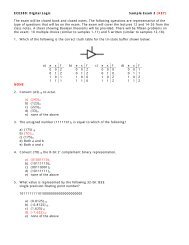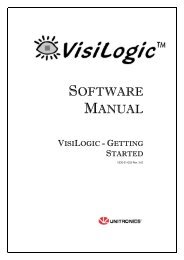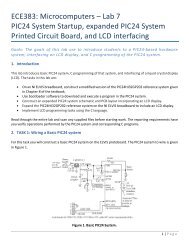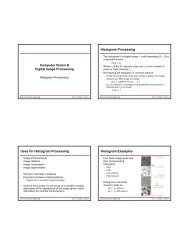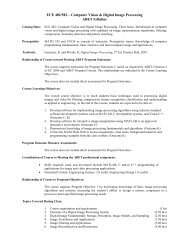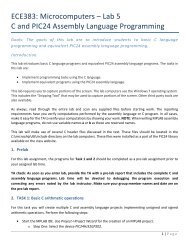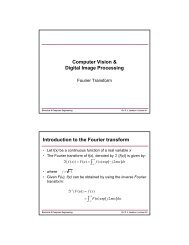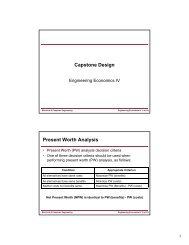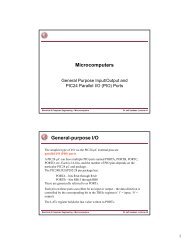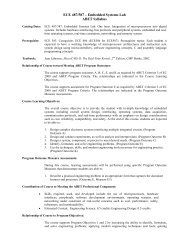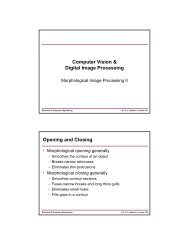Digital Systems Design VHDL coding basics
Digital Systems Design VHDL coding basics
Digital Systems Design VHDL coding basics
Create successful ePaper yourself
Turn your PDF publications into a flip-book with our unique Google optimized e-Paper software.
<strong>Digital</strong> <strong>Systems</strong> <strong>Design</strong>Guidelines for <strong>VHDL</strong>-based <strong>Design</strong>Electrical & Computer EngineeringDr. D. J. Jackson Lecture 4-1<strong>VHDL</strong> <strong>coding</strong> <strong>basics</strong>• Here, we describe a set of basic guidelines for<strong>coding</strong> in <strong>VHDL</strong>• The objective is to produce readable <strong>VHDL</strong> sourcethat is targeted for synthesis• Many factors affect the ultimate performance of a<strong>VHDL</strong>-based design including– <strong>VHDL</strong> <strong>coding</strong> style– EDA tool(s) used: synthesis and place/route– Characteristics of the target device– User/designer awareness of how the above 3 itemsinteract and depend on each otherElectrical & Computer EngineeringDr. D. J. Jackson Lecture 4-21
Sources of information• Various sources of information exist that shouldhelp you learn and use good <strong>coding</strong> practice– Altera online help in Quartus II gives a set of guidelinesfor <strong>VHDL</strong> <strong>coding</strong>– Altera website provides numerous design examples– Various <strong>VHDL</strong>-related websites• Use with caution• Do not attempt to code what you do not understandElectrical & Computer EngineeringDr. D. J. Jackson Lecture 4-3Sources of information (continued)• Various internet resources– Altera provided design examples• www.altera.com/support/examples/exm-index.html– Literature for various Altera device families• CYCLONE IV -- www.altera.com/literature/lit-cyclone-iv.jsp– Various related sources• www.eeproductcenter.com – Numerous IC resources includingFPGAs• www.fpga-faq.com – FPGA FAQ• www.fpga4fun.com – Various FPGA projects• www.google.com – search for FPGAElectrical & Computer EngineeringDr. D. J. Jackson Lecture 4-42
Simulation accuracy and speed• Accuracy– Ensure the sensitivity list of process statements iscomplete• Speed– Use a process statement in preference to concurrentsignal assignments• Reduces the number of signals a simulator must continuallymonitor for changes and so improves simulation speed– <strong>Design</strong> models to minimize the number of signals in aprocess statement• Less signals to monitor will improve simulation speed– Do not model many small process statements• If there are many registers being clocked from the same clocksource, it is better to put them in one process.Electrical & Computer EngineeringDr. D. J. Jackson Lecture 4-5Synthesis modeling recommendations• When modeling purely combinational logic, ensuresignals are assigned in every branch of conditionalassignment statements• Use case statements in preference to if statementscontaining else-if clauses• The others default case branch ensures all branchvalues are covered.• There is no real need to use a wait statement toinfer flip-flops.– The if statement can do all that wait does and has theadded advantage that combinational logic can be inferred.Source: D. J. Smith, HDL Chip <strong>Design</strong>, Doone Publications, 2001.Electrical & Computer EngineeringDr. D. J. Jackson Lecture 4-63
General HDL modelingrecommendations• Before attempting to code a model, know and understandwhat it is you are modeling• Divide your design into sub-designs when possible• Promotes short, easy to read, reusable code• Make models as generic as possible• Parameterize bus widths• Use meaningful signal names.• For active low signals use _n for clearer understandingand easier debugging• Use comments liberally.• A header should describe each module and each signal declarationshould have a comment• Dated, inconsistent comments are worse than none at all.Electrical & Computer EngineeringDr. D. J. Jackson Lecture 4-7Assigning Values in Different NumberFormats• Assignment statements (with <strong>VHDL</strong> 1993 syntax) can usedifferent number formats as appropriate– X (hex), O (Octal)• Assume reg is STD_LOGIC_VECTOR(7 DOWNTO 0)reg
<strong>VHDL</strong> Aggregates• An aggregate is a collection of items that are gatheredtogether to form a total quantity.signal v : std_logic_vector(7 downto 0);v '0'); -- "00000000"v '0'); -- "10000000"v '1', others => '0'); -- "00010000"v '0', others => '1'); -- "11110000"-- v '1'); -- illegal!Electrical & Computer EngineeringDr. D. J. Jackson Lecture 4-9<strong>VHDL</strong> Generics• <strong>VHDL</strong> generics may be used to parameterize codemaking components as modular (and hence)reusable as possibleFor example:entity counters isgeneric ( width : integer := 8 );port(d : in std_logic_vector(width-1 downto 0);clk : in std_logic;clear : in std_logic;load : in std_logic;up_down : in std_logic;qd : out std_logic_vector(width-1 downto 0));end counters;Electrical & Computer EngineeringDr. D. J. Jackson Lecture 4-105



